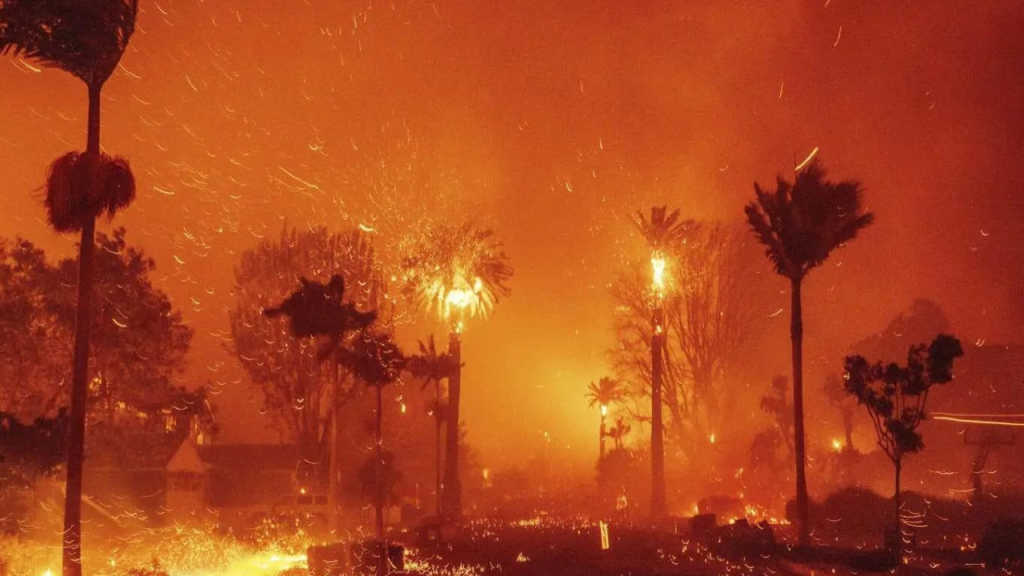WESTMINSTER, CO — A Colorado-based company is playing a crucial role in assisting first responders during the ongoing wildfire crisis in Southern California. Maxar Intelligence, located in Westminster, specializes in space technology and satellite imagery, providing vital information that helps first responders combat the raging fires and assess the damage.
While millions of people have seen the heart-wrenching images of wildfires burning homes and communities in California, a different type of imagery is also helping authorities understand the full extent of the damage. Maxar Intelligence is capturing high-resolution satellite images of the fire-affected areas, providing a broader view of the devastation.
Maxar Intelligence’s Role in Wildfire Response
Maxar Intelligence uses its advanced satellite network to capture images from around the world, with a particular focus on natural disasters. In the case of the Southern California wildfires, the company has been using its constellation of six satellites to collect real-time data and imagery of the affected areas.
Jeff Robertson, the Chief Operations Officer at Maxar Intelligence, explained that the company’s satellites are specifically focused on disaster zones. “We try to focus initially on the immediate disaster areas, where the active fires are burning so that we can help the first responders,” Robertson said. The company’s satellites use various wavelengths, including short-wave infrared sensors, to capture detailed images of the fire areas, even through smoke.
The company has already provided over 24,000 square kilometers of imagery to help emergency services. The images generated by Maxar Intelligence assist various agencies, including FEMA (Federal Emergency Management Agency), NOAA (National Oceanic and Atmospheric Administration), and other first responders on the ground, in their firefighting efforts.
Free Access to Imagery for Emergency Services
One of the unique aspects of Maxar Intelligence’s contribution is their open data program. Through this program, Maxar provides the high-resolution satellite imagery free of charge to key government agencies and first responders. This enables authorities to make more informed decisions when it comes to planning firefighting efforts, identifying fire lines, and understanding the current situation on the ground.
“We provide that imagery through our open data program, free of charge to key agencies, government agencies, to kind of look at it and help with logistical planning, fire lines, understanding kind of the situation on the ground,” Robertson said.
The detailed imagery allows emergency services to track active hotspots, assess the spread of the fires, and make crucial decisions about where to allocate resources. This kind of satellite data is especially important when on-the-ground access is limited or dangerous.
Assisting in Post-Fire Recovery
While the primary goal of Maxar’s satellite imagery is to support firefighting efforts, the technology also plays a critical role in the recovery phase once the fires have been contained. After the flames have been extinguished, satellite images can help identify the areas most in need of repairs, such as damaged utilities, infrastructure, and roads.
Robertson explained that the images are valuable for a variety of purposes. “Utility companies, for example, can use the imagery to understand what needs to be repaired,” he said. “Mapping companies can look at what’s damaged, and roads that are now inaccessible can be identified.”
The satellite images can also assist homeowners in assessing the damage to their properties. While it may be difficult for insurance adjusters to reach remote or hazardous areas, satellite imagery can provide a clear before-and-after view of the damage. This can be helpful for residents in starting the claims process with insurance companies.
“You may not be able to send an adjuster to an area, but you can use the imagery to do initial assessments and possibly start claims processes,” Robertson said. “Helping the residents get supported a little bit early.”
Maxar’s Impact During the 2021 Marshall Fire
Maxar Intelligence has been instrumental in past disaster response efforts as well. The company’s satellite imagery was used to support local first responders during the 2021 Marshall Fire in Colorado, providing crucial data that helped emergency teams manage the situation.
The Marshall Fire, which was one of the most destructive wildfires in Colorado history, caused widespread damage and forced thousands of people to evacuate. Maxar’s imagery helped authorities assess the extent of the damage and make more effective decisions in their emergency response.
How Satellite Imagery Helps in Disaster Situations
Satellite imagery has become an essential tool in modern disaster management. For wildfires, these images provide a unique vantage point, allowing first responders to assess large areas of land that may be inaccessible due to smoke, fire, or terrain. The ability to track fire progression, monitor hot spots, and analyze damage in real-time is invaluable to firefighting teams and recovery operations.
In addition to providing vital information for fire management, satellite images also support long-term recovery efforts. As communities begin to rebuild after a wildfire, Maxar’s images can help utility companies and other service providers understand the extent of the damage and prioritize repairs.
The role of Maxar Intelligence in the ongoing Southern California wildfire response highlights the importance of advanced technology in disaster relief. With its satellite constellation and cutting-edge imagery, Maxar is helping first responders navigate the challenges of firefighting and recovery, ultimately saving lives and supporting communities in need.
The Future of Satellite Technology in Disaster Management
As natural disasters like wildfires become more frequent and intense, the demand for accurate, real-time data is growing. Companies like Maxar Intelligence are at the forefront of providing this data, and their role in disaster response is likely to expand in the coming years.
The continued advancement of satellite technology, combined with data-sharing programs like Maxar’s open data initiative, ensures that first responders and recovery teams have the tools they need to effectively manage disasters and help affected communities rebuild.
Disclaimer – Our editorial team has thoroughly fact-checked this article to ensure its accuracy and eliminate any potential misinformation. We are dedicated to upholding the highest standards of integrity in our content.





More Stories
Maxar Intelligence Provides Satellite Images to Help Firefighters Tackle California Wildfires
Maxar Intelligence Provides Satellite Images to Help Firefighters Tackle California Wildfires
Maxar Intelligence Provides Satellite Images to Help Firefighters Tackle California Wildfires